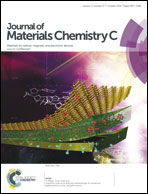Heteroaromatic variation in amorphous 1,6-methano[10]annulene-based charge-transporting organic semiconductors†
Abstract
π-Conjugated 1,6-methano[10]annulene-diketopyrrolopyrrole copolymers containing thiophene and/or furan rings were synthesized to determine the tolerance of heteroaromatic composition for amorphous semiconductors. Thiophene and furan were incorporated within the conjugated main chain adjacent to the annulene and diketopyrrolopyrrole comonomers to influence the optoelectronic properties of the highly disordered bulk materials. All polymers synthesized were shown to be amorphous by differential scanning calorimetry despite the relatively low alkyl chain substitution. The furan-containing copolymers showed higher energy bandgaps (HOMO–LUMO gaps) than the thiophene-based polymers, but increasing furan substitution resulted in higher hole mobilities: values ranged from 1.6 × 10−4 cm2 V−1 s−1 for all-thiophene polymers to 7.0 × 10−4 cm2 V−1 s−1 for all-furan polymers. AFM images reveal that the furan containing polymers form higher-quality films upon solution processing, a consequence of the higher solubility of the furan-based polymers. These results add to the growing literature precedent illustrating the value of furan as a component of both semicrystalline and now amorphous conjugated polymers.
![Graphical abstract: Heteroaromatic variation in amorphous 1,6-methano[10]annulene-based charge-transporting organic semiconductors](/en/Image/Get?imageInfo.ImageType=GA&imageInfo.ImageIdentifier.ManuscriptID=C4TC01326C&imageInfo.ImageIdentifier.Year=2014)

 Please wait while we load your content...
Please wait while we load your content...